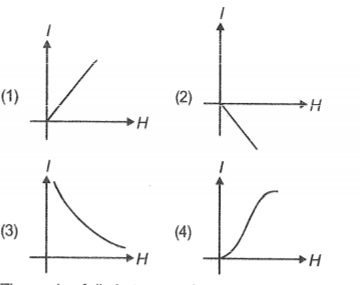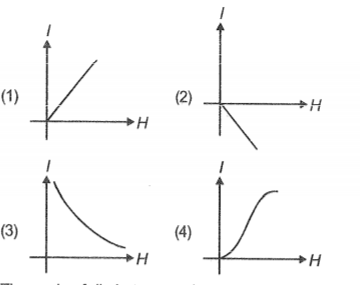The magnetic moment of a diamagnetic atom is
(a) much greater than one
(b) one
(c) between zero and one
(d) equal to zero
प्रतिचुंबकीय परमाणु का चुंबकीय आघूर्ण होता है-
(a) एक से बहुत अधिक
(b) एक
(c) शून्य और एक के बीच
(d) शून्य के बराबर
The magnetic susceptibility of a diamagnetic material depends on absolute temperature T as :
एक चुंबकीय पदार्थ की चुंबकीय प्रवत्ति χ, परम ताप T पर किस प्रकार निर्भर करती है:
The force between two magnetic poles of strength unity at a separation of 1 m is
1 मीटर के पृथक्करण पर इकाई सामर्थ्य के दो चुंबकीय ध्रुवों के बीच बल है:
The material which is used to make permanent magnets has -
1. High retentivity, low coercivity
2. Low retentivity, low coercivity
3. Low retentivity, high coercivity
4. High retentivity, high coercivity
पदार्थ जो स्थायी चुंबक बनाने के लिए उपयोग की जाती है-
1. उच्च धारणशीलता, निम्न निग्रहिता
2. निम्न धारणशीलता, निम्न निग्रहिता
3. निम्न धारणशीलता, उच्च निग्रहिता
4. उच्च धारणशीलता, उच्च निग्रहिता
A substance is placed in an external magnetic field. If the direction of induced dipole moment is opposite to the direction of the applied magnetic field, then the substance may be
1. Paramagnetic
2. Diamagnetic
3. Ferromagnetic
4. Both (1) & (3)
किसी पदार्थ को बाहरी चुंबकीय क्षेत्र में रखा जाता है। यदि प्रेरित द्विध्रुवीय आघूर्ण की दिशा अनुप्रयुक्त चुंबकीय क्षेत्र की दिशा के विपरीत है, तो पदार्थ हो सकता है:
1. अनुचंबकीय
2. प्रति-चुंबकीय
3. लौह-चुंबकीय
4. (1) और (3) दोनों
If Bo is magnetic flux density in vacuum produced by a magnetising force and magnetic flux density produced by the magnetisation of a material due to the same magnetising force is Bm, then the total magnetic flux density in the material is :
यदि किसी चुम्बकीय बल द्वारा निर्वात में उत्पन्न चुम्बकीय फ्लक्स घनत्व Bo हो और उसी चुम्बकीय बल के कारण किसी पदार्थ के चुंबकत्व द्वारा उत्पन्न चुम्बकीय फ्लक्स घनत्व Bm हो, तो पदार्थ में कुल चुंबकीय फ्लक्स घनत्व है:
A magnet (primary) oscillates with frequency in earth's magnetic field (BH) alone. Now a secondary magnet is placed near the primary magnet. If B is the magnetic field of the second magnet on the primary magnet in the direction of BH, the primary magnet oscillates with frequency , then the ratio of B/BH is :
1.
2. -1
3. + 1
4. -1
एक चुंबक (प्राथमिक) अकेले पृथ्वी के चुंबकीय क्षेत्र (BH) में आवृत्ति से दोलन करता है। अब एक द्वितीयक चुंबक को प्राथमिक चुंबक के निकट रखा जाता है। यदि B, BH की दिशा में प्राथमिक चुंबक पर द्वितीयक चुंबक का चुंबकीय क्षेत्र है, प्राथमिक चुंबक आवृत्ति से दोलन करता है, तब B/BH का अनुपात ज्ञात कीजिए:
1.
2. -1
3. + 1
4. -1
Which of the following graphs represents the correct variation of the intensity of magnetisation (l) with the intensity of the magnetising field (H) in a ferromagnetic substance?

निम्नलिखित में से कौन सा ग्राफ लौह- चुंबकीय पदार्थ में चुंबकत्व क्षेत्र (H) की तीव्रता के साथ चुंबकन (l) की तीव्रता के सही परिवर्तन को निरूपित करता है?

Which of the following is not dimensionless? (where symbols stand for their usual meanings in magnetism)?
1.
2.
3.
4.
निम्नलिखित में से कौन विमाहीन नहीं है? (जहाँ चुंबकत्व में उनके प्रतीको के लिए सामान्य अर्थ होते हैं)?
1.
2.
3.
4.
A magnetic needle makes n oscillations per minute in a horizontal plane where the angle of dip is 45. If the needle is made to oscillate in a vertical plane coinciding with the magnetic meridian, then the number of oscillations per minute will become/remains
1. n
2. n
3. (2)1/4 n
4. n/2
एक चुंबकीय सुई एक क्षैतिज समतल में प्रति मिनट n दोलन करती है जहां नति कोण 45 होता है। यदि सुई चुंबकीय याम्योतर के साथ सम्पाती ऊर्ध्वाधर समतल में दोलन करने के लिए बनी होती है, तो प्रति मिनट दोलनों की संख्या बन जाएगी / रहेगी:
1. n
2. n
3. (2)1/4 n
4. n/2






